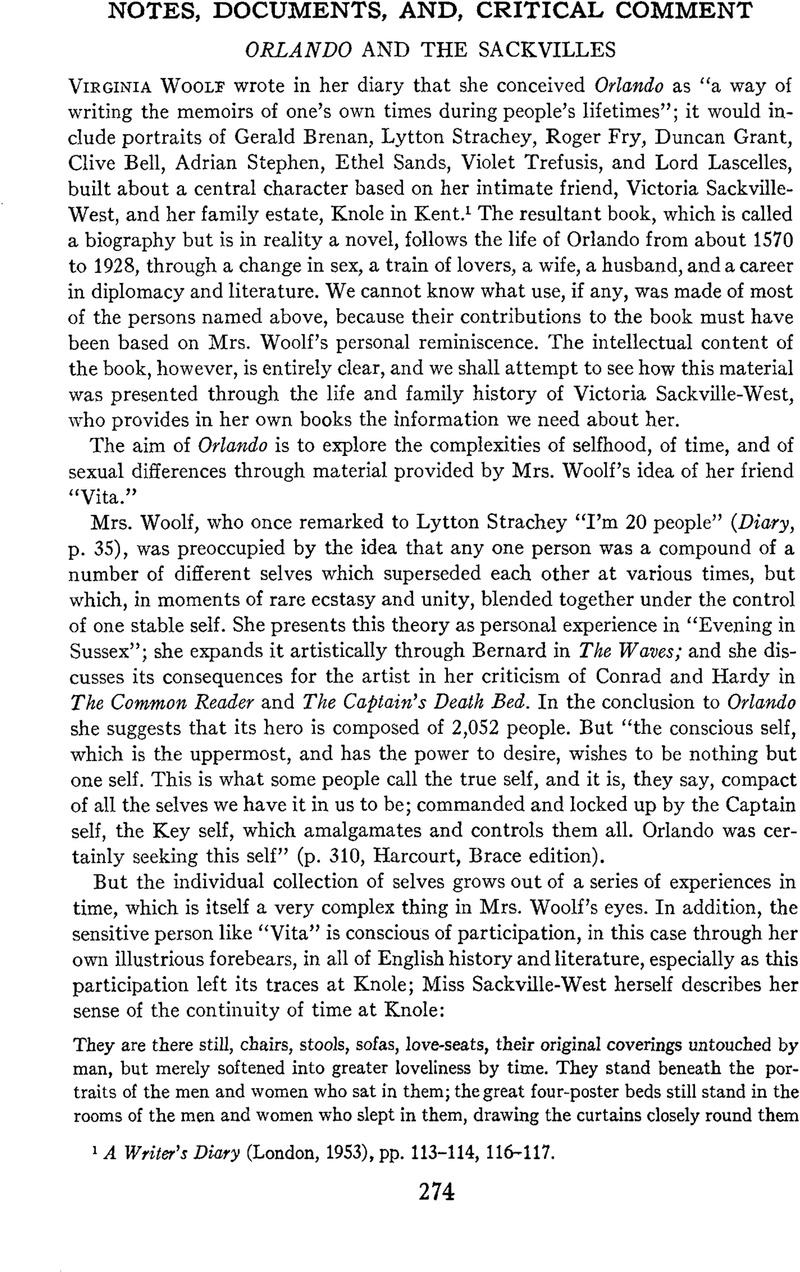Article contents
Orlando and the Sackvilles
Published online by Cambridge University Press: 02 December 2020
Abstract

- Type
- Notes, Documents, and Critical Comment
- Information
- Copyright
- Copyright © Modern Language Association of America, 1955
References
1 A Writer's Diary (London, 1953), pp. 113–114, 116–117.
2 “Knole,” Arts and Decoration, xlv (Dec. 1936), 21–22. This article was apparently written as a plea to keep Knole intact; it has since become government property.
3 (New York, n.d., preface dated May–June 1922).
4 Knole is unique in possessing 5 Elizabethan upholstered chairs with original covering intact. R. W. Symonds, “The Upholstered Furniture at Knole,” Burlington Mag., lxxxvi (May and July 1945).
5 (Garden City, New York, 1937).
6 The frontispiece reproduces only half the portrait, which also includes Edward's brother, Richard, Lord Buckhurst. The entire portrait is reproduced in Knole, facing p. 106. A full-length reproduction of the portrait of Mary can be found in H. K. Morse, Elizabethan Pageantry, special Spring number of The Studio (London and New York, 1934), p. 59. This painting was offered for sale in America; see Art Digest, vi (15 Jan. 1932), 7.
7 The lines quoted are on p. 49 of the 1926 edition of the poem.
8 How well Mrs. Woolf knew the ways of writers is illustrated by the incredible irony of the history of this book. In the novel Mrs. Woolf relates how Orlando, during Elizabethan times, invited Nick Greene to his estate for a short visit, and when Greene left, he started a new poem: “The subject was made for him. A noble Lord at home. A visit to a Nobleman in the country—his new poem would have some such title as that. Seizing the pen … Greene dashed off a very spirited satire there and then. It was so done to a turn that no one could doubt that the young Lord who was roasted was Orlando; his most private sayings and doings, his enthusiasms and follies, down to the very colour of his hair and the foreign way he had of rolling his r's were there to the life” (p. 95). Now just such a satire, The Georgiad, appeared in 1933 from the pen of Roy Campbell, and it constituted, in one of the most obscene and vituperative satires in print, an attack on the Bloomsbury group, its mannerisms, its way of speech, and its most intimate mores. Campbell explained his reason for the attack in Broken Record (London, 1934), pp. 161–166; subsequently Stephen Spender in his autobiography World Within World (London, 1951), p. 152, alluded to the effect of the satire on Mrs. Woolf, and maintained it was poor payment for hospitality that had been extended to Campbell. In Light on a Dark Horse (London, 1951), pp. 255–259, Campbell replied to Spender, alluding to Sevenoaks, which is the village near Knole. From this evidence, it is apparent that Victoria Sackville-West and her husband Harold Nicolson (whose name appears in the satire) were the hosts involved, and that they, along with Virginia Woolf, were the targets. The hermaphroditic protagonist of The Georgiad is at one point compared to Orlando, as he arises with a “virginally vulpine air”; it is apparent that Campbell, like Greene, wanted to leave no doubt about who was being roasted. For his poem, see The Collected Poems of Roy Campbell (London, 1949), pp. 201–242.
- 1
- Cited by




